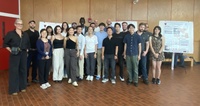Abstract:
In tissues and organs, the extracellular matrix (ECM) helps maintain inter- and intracellular architectures that sustain the structure–function relationships defining physiological homeostasis. Combining fiber scaffolds and cells to form engineered tissues is a means of replicating these relationships. Engineered tissues' fiber scaffolds are designed to mimic the topology and chemical composition of the ECM network. Here, we asked how cells found in the heart compare in their propensity to align their cytoskeleton and self-organize in response to topological cues in fibrous scaffolds. We studied cardiomyocytes, valvular interstitial cells, and vascular endothelial cells as they adapted their inter- and intracellular architectures to the extracellular space. We used focused rotary jet spinning to manufacture aligned fibrous scaffolds to mimic the length scale and three-dimensional (3D) nature of the native ECM in the muscular, valvular, and vascular tissues of the heart. The representative cardiovascular cell types were seeded onto fiber scaffolds and infiltrated the fibrous network. We measured different cell types' propensity for cytoskeletal alignment in response to fiber scaffolds with differing levels of anisotropy. The results indicated that valvular interstitial cells on moderately anisotropic substrates have a higher propensity for cytoskeletal alignment than cardiomyocytes and vascular endothelial cells. However, all cell types displayed similar levels of alignment on more extreme (isotropic and highly anisotropic) fiber scaffold organizations. These data suggest that in the hierarchy of signals that dictate the spatiotemporal organization of a tissue, geometric cues within the ECM and cellular networks may homogenize behaviors across cell populations and demographics.
